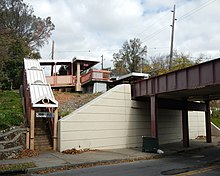


An embankment is a raised wall, bank or mound made of earth or stones, that are used to hold back water or carry a roadway. A road, railway line, or canal is normally raised onto an embankment made of compacted soil (typically clay or rock-based) to avoid a change in level required by the terrain, the alternatives being either to have an unacceptable change in level or detour to follow a contour. A cutting is used for the same purpose where the land is originally higher than required.
Embankments are often constructed using material obtained from a cutting. Embankments need to be constructed using non-aerated and waterproofed, compacted (or entirely non-porous) material to provide adequate support to the formation and a long-term level surface with stability. An example material for road embankment building is sand-bentonite mixture often used as a protective to protect underground utility cables and pipelines.[1]
To intersect an embankment without a high flyover, a series of tunnels can consist of a section of high tensile strength viaduct (typically built of brick and/or metal) or pair of facing abutments for a bridge.[clarification needed]